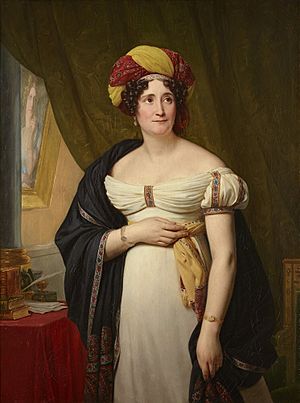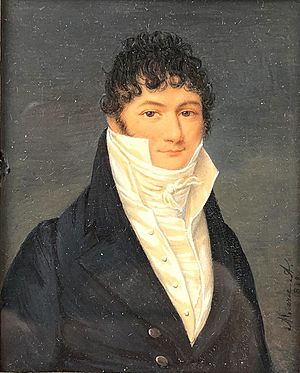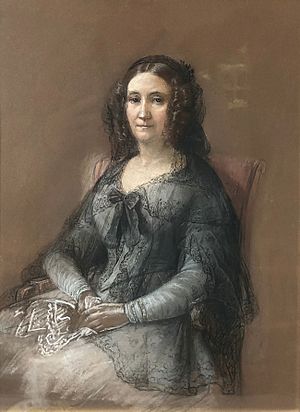Sophie Gay facts for kids
Marie Françoise Sophie Gay (born Nichault de la Valette) was a French writer. She was born in Paris on July 1, 1776, and passed away on March 2, 1852.
Quick facts for kids
Sophie Gay
|
|
|---|---|

Portrait of Sophie Gay, 1824, by Louis Hersent
|
|
| Born | 1 July 1776 Paris
|
| Died | 2 March 1852 (aged 75) |
| Occupation | author |
Contents
Sophie Gay's Early Life and Marriages
Marie Françoise Sophie Nichault de la Vallette was the daughter of Francesca Peretti, who was Italian. Her father, Auguste Antoine Nichault de la Valette, was a businessman. He worked for Louis XVIII of France.
Sophie first married Gaspard Liottier in 1794. She divorced him in 1799. Then, she married Jean Sigismond Gay (1768–1822). He was the mayor of Lupigny and came from Aix-les-Bains. He also worked closely with the French government's money department during the First French Empire. He was a top financial officer for the Ruhr region.
Sophie Gay's Social Life and Connections
This second marriage helped Sophie and her husband become part of high society. They spent much of their lives with important people in Aix-la-Chapelle. They also spent time with those who were trying to develop the town of Spa, Belgium. A famous person they knew was Pauline Bonaparte, who was Napoleon's sister.
Sophie had a special gathering place called a salon. Here, women who loved to talk about news and ideas would meet. Artists, musicians, writers, and painters also often joined these gatherings. They liked Sophie for her cleverness, beauty, and generosity.
Sophie Gay's Writing Career
Sophie published her first written work in 1802. It was a defense of novels as an art form. She wrote an open letter to the Journal de Paris. This letter was about the novel Delphine by Germaine de Staël.
In the same year, her first novel, Laure d’Estell, was published without her name on it. Her publishers, Sir Stanislas de Boufflers and Joseph-Alexandre Pierre de Ségur, Viscount of Ségur, suggested this.
Ten years later, Sophie published Léonie de Montbreuse. The writer Charles Augustin Sainte-Beuve praised it as her best novel. However, her 1815 story, Anatole, about lost love, might be her most famous work.
After her first successful novel, Sophie wrote many others. They were known for their good style and sincere feelings. In 1837, she wrote Salons célèbres, which was also highly praised.
Sophie also worked in the theatre. She wrote several comedies for plays. She also wrote libretti, which are the words for operas.
Sophie Gay's Legacy and Later Life
Sophie Gay was the mother of the famous writer Delphine de Girardin. Her son-in-law married the singer Sophie Gail.
In 1818, Sophie wrote the words for an opéra comique (a type of comic opera) called la Sérénade. Sophie Gail then wrote the music for it. In 1821, Sophie was working on Chanoine de Milan by Alexandre Duval. She also worked on a comic opera called le Maitre de Chapelle ("Master of the House").
Sophie also wrote many other comedies and dramas. Her comedy la Veuve du tanneur ("The tanner's widow") was very successful. However, her play Duchesse de Châteauroux did not do well at the Théâtre de l'Odéon.
Sophie also wrote many "novel novels," called Nouvelles nouvelles. These were like short, exciting stories often sold cheaply. She wrote them for the newspaper La Presse. Sophie was also a talented musician. She published many romantic songs that she wrote both the words and music for. Maris is a good example of her songs.
After her husband passed away, Sophie took a long trip to Italy with her son. This trip happened between 1826 and 1827.
In her later years, Sophie lived in Versailles during the social "season." One of Sophie's daughters became the Countess O'Donnell. Her other daughter, Delphine de Girardin, became very famous. She was married to Émile de Girardin.
Sophie Gay's Published Works
- Laure d’Estell (1802)
- Léonie de Montbreuse (1813)
- Anatole (1815)
- Les Malheurs d’un Amant heureux (1818)
- Le Marquis de Pomenars (1820)
- Une Aventure du chevalier de Grammont (1822)
- Marie, ou la pauvre fille (1824)
- Théobald, épisode de la guerre de Russie (1828)
- Le Moqueur amoureux (1830)
- Un Mariage sous l’empire (1832)
- Scènes du jeune âge (1833)
- la Physiologie du Ridicule (1833)
- Souvenirs d’une vieille femme (1834)
- La Duchesse de. Châteauroux (1834)
- Le Chevalier de Canolle (1836)
- la Comtesse d’Egmont (1836)
- Les Salons célèbres (1837)
- Marie de Mancini (1840)
- Marie-Louise d’Orléans (1842)
- la Duchesse de Chateauroux (1844)
- Ellénore (1844–1846)
- Le joui Frère (1845)
- Le Comte de Guiche (1845)
- Le Mari confident (1849)
- Société du Travail à domicile (1849)
- Œuvres complètes de Sophie Gay (1864–1885)
About Sophie Gay's Life Story
You can learn more about Sophie Gay from her daughter, Delphine de Girardin's, writings. Sophie herself wrote a book in 1834 called Souvenirs d'une vieille femme, which means "memoirs from an old woman." You can also find information in books by Théophile Gautier and Charles Augustin Sainte-Beuve.



